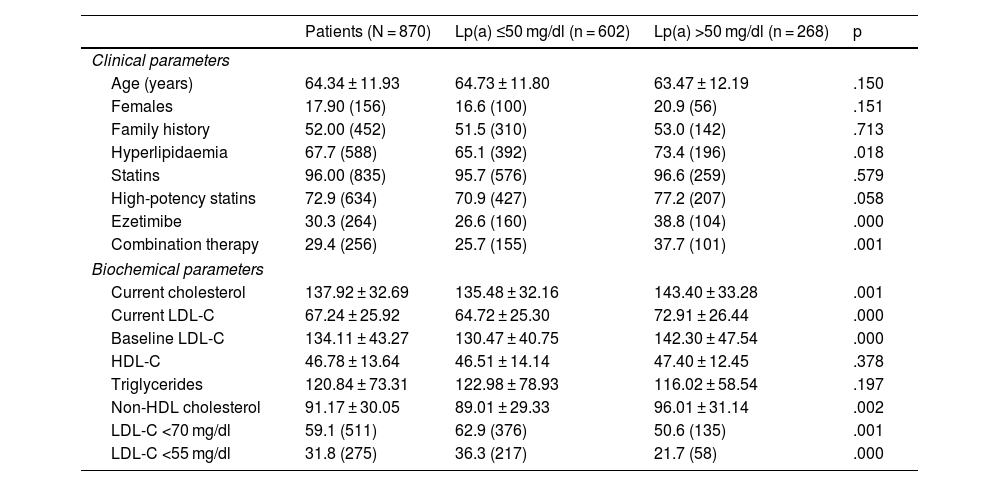Lipoprotein (a) [Lp(a)] concentration influences serum low-density lipoprotein cholesterol (LDL-C) levels. How it influences the achievement of LDL-C targets established in the guidelines is not well studied. Our aim was to know the prevalence of elevated Lp(a) levels in patients with coronary artery disease (CAD), and to assess its influence on the achievement of LDL-C targets.
MethodWe conducted a cross-sectional study in a Cardiology department in Spain. A total of 870 patients with stable CAD had their lipid profile determined, including Lp(a). Patients were stratified into two groups according to Lp(a) >50 mg/dL and Lp(a) ≤50 mg/dL. The association of Lp(a) >50 mg/dL with achievement of LDL-C targets was assessed by logistic regression analysis.
ResultsThe prevalence of Lp(a) >50 mg/dL was 30.8%. Patients with Lp(a) >50 mg/dL had higher baseline (142.30 ± 47.54 mg/dL vs 130.47 ± 40.75 mg/dL; p = 0.0001) and current (72.91 ± 26.44 mg/dL vs 64.72 ± 25.30 mg/dL; p = 0.0001), despite the fact that they were treated with more high-potency statins (77.2% vs 70.9%; p = 0.058) and more combination lipid-lowering therapy (LLT) (37.7% vs 25.7%; p = 0.001). The proportion of patients achieving target LDL-C was lower in those with Lp(a) >50 mg/dL. Independent predictors of having elevated Lp(a) levels >50 mg/dL were the use of high-potency statins (OR 1.5; 95% CI 1.08−2.14), combination LLT with ezetimibe (OR 2.0; 95% CI 1.45−2.73) and failure to achieve a LDL-C ≤55 mg/dL (OR 2.3; 95% CI 1.63−3.23).
ConclusionsElevated Lp(a) levels influence LDL-C levels and hinder the achievement of targets in patients at very high cardiovascular risk. New drugs that act directly on Lp(a) are needed in these patients.
La concentración de lipoproteína (a) [Lp(a)] influye en los niveles séricos de colesterol de las lipoproteínas de baja densidad (C-LDL). Cómo influye en la consecución de objetivos de C-LDL establecidos en las guías no está bien estudiado. Nuestro objetivo fue conocer la prevalencia de niveles elevados de Lp(a) en pacientes con enfermedad arterial coronaria (EAC), y evaluar su influencia en la consecución de objetivos de C-LDL.
MétodoRealizamos un estudio transversal en un servicio de Cardiología en España. A un total de 870 pacientes con EAC estable les determinamos el perfil lipídico, incluida Lp(a). Los pacientes se estratificaron en dos grupos según Lp(a) >50 mg/dL y Lp(a) ≤50 mg/dL. La asociación de Lp(a) >50 mg/dL con la consecución de objetivos de C-LDL se evaluó mediante análisis de regresión logística.
ResultadosLa prevalencia de Lp(a) >50 mg/dL fue de 30,8%. Los pacientes con Lp(a) >50 mg/dL tenían un C-LDL más elevado, tanto basal (142,30 ± 47,54 mg/dL vs 130,47 ± 40,75 mg/dL; p = 0,0001) como actual (72,91 ± 26,44 mg/dL vs 64,72 ± 25,30 mg/dL; p = 0,0001), a pesar de que estaban tratados con más estatinas de alta potencia (77,2% vs 70,9%; p = 0,058) y más tratamiento hipolipemiante (THL) de combinación (37,7% vs 25,7%; p = 0,001). La proporción de pacientes que alcanzaron el objetivo de C-LDL fue menor en aquellos con Lp(a) >50 mg/dL. Fueron predictores independientes de tener niveles elevados de Lp(a) >50 mg/dL, la utilización de estatinas de alta potencia (OR 1.5; 95% CI 1.08–2,14), el THL de combinación con ezetimiba (OR 2,0; 95% CI 1,45−2,73) y la no consecución de un C-LDL ≤55 mg/dL (OR 2,3; 95% CI 1,63−3,23).
ConclusionesLos niveles elevados de Lp(a) influyen en los niveles de LDL-C y dificultan la consecución de objetivos en pacientes de muy alto riesgo cardiovascular. En estos pacientes son necesarios nuevos fármacos que actúen directamente sobre Lp(a).










